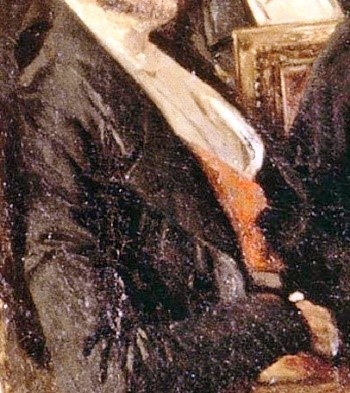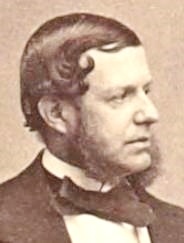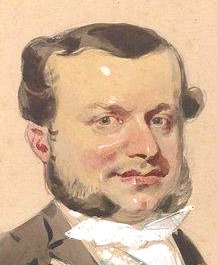Francisco-José de Païva, viscount (1815-1868), Portuguese minister
1stimage: Soirée; 2nd: Cordon rouge; 3rd: Disderi (1860s); 4th: caricature drawn by Giraud on February 12, 1858 at de Nieuwerkerke's soirée; (Alternative: Parseval)
Francisco-José de Païva Pereira, 1st Viscount of Paiva (Portugal), first attended de Nieuwerkerke’s vendredi-soirée on December 21, 1851, as recorded in the Ménéstrel weekly art and theatre journal. As an avid art collector, his presence among artists and conservators would be far more fitting than that of Admiral Parseval.
He wears the cordon rouge sash, denoting the rank of Grand Officer in the Legion of Honor. Viscount Païva received this distinction in August 1854—by which time Soirée au Louvre was largely completed but subject to modifications at de Nieuwerkerke’s orders, or possibly even by the emperor himself. If the Portuguese minister had already been included, Biard would have added the sash to reflect Païva’s elevated status. It would have been inappropriate to depict a foreign minister at a lower honor level.
Francisco de Païva was the son of José Caetano Pereira de Paiva, a knight of the Royal House and member of the Supreme Court, and his wife, Dona Ana Sofia Thompson. He began his career in April 1838 as a second-class clerk at the Secretariat of Foreign Affairs in Oporto, later relocating to London in 1843 to assist the Duke of Palmela and the Viscount of Castelões.
On December 19, 1838, he married Carlota de Oliveira Maia, daughter of Antonio Maia, a knight of the Royal House, and Dona Ana Joaquina da Silva Maia.
Note: Madame Païva was not the infamous courtesan and diamond-lover, Marquise La Païva (Thérèse Lachman). She had married a cousin of the Viscount, a marquess, and became part of an artistic elite, mingling with figures such as George Sand, Chopin, Delacroix, Renoir, and Scheffer, while reportedly seducing many more.
Francisco Païva served as secretary of the Portuguese legation from 1845, later rising to chargé d'affaires. A brief assignment in Berlin did not suit him, leading him to remain in France, where he was appointed Extraordinary Envoy and Plenipotentiary Minister in 1852. He briefly served in Russia before returning to Paris the same year. He was granted the title of baron in December 1853 and viscount on April 30, 1858.
Despite his diplomatic success, his lavish upper-class lifestyle in Paris, coupled with mounting gambling debts, ultimately made his position untenable. Forced to relocate to Berlin, he tragically took his own life in 1868.
His extensive art collection now forms part of the Museu Nacional de Arte Antiga in Lisbon.



